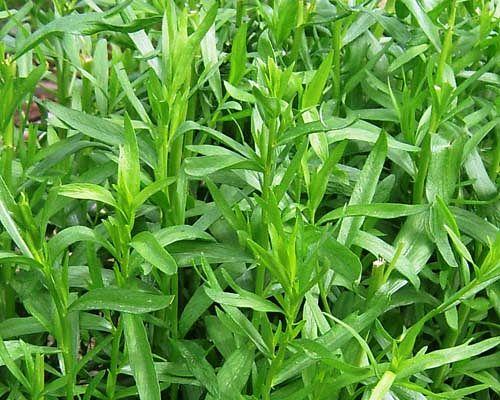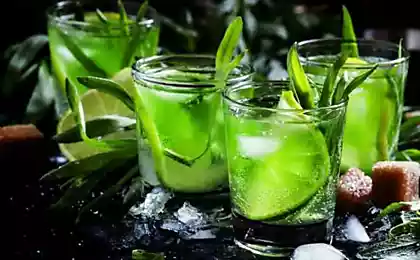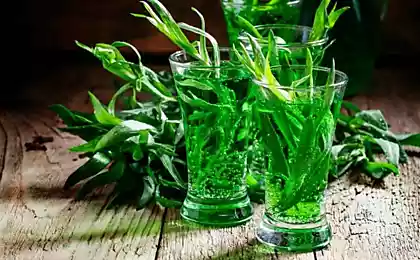1287
Tarragon (Tarragon) - a medicinal plant

Tarragon - a perennial herb of the family Asteraceae. The only species of wormwood, which is devoid of bitterness, and thus has a strong spicy aroma and spicy spicy taste, so it is widely used as a seasoning. In cooking, use herbs tarragon and fresh, and dried. The leaves of this plant are added in pickling cucumbers, tomatoes, in marinades, with sauerkraut and mushrooms. Young green tarragon put in soups, broths, salads.
Also, tarragon is used to flavor wines and liqueurs, and it is prepared by adding a well-known soft drink "Tarragon».
Tarragon - useful properties and contraindications
In addition to use in cooking, tarragon and is known as a medicinal plant.
The Tarragon leaves contain essential oil, a large amount of carotene and vitamin C, coumarin, minerals and tannins, resins. It has anti-inflammatory, antiseptic, sedative, tonic, diuretic.
Harm tarragon able to cause only when used in very large quantities, and to extract the maximum benefit, you need to eat it slowly.
In addition, tarragon is contraindicated during pregnancy because it can cause miscarriage, and cholelithiasis. Other obvious contraindications to the use of herbs tarragon does not exist, but, as with any herbal remedies, there may be cases of individual intolerance.
Medicinal properties of tarragon
Useful properties of tarragon known since ancient times, and found a very wide use in folk medicine. The mention of the medicinal properties of this plant are found in the writings of a Spanish physician and botanist Ibn Baytera, who lived in the XIII century.
Tarragon is used as a remedy for headache, toothache, insomnia, depression, to improve appetite and stimulate digestion, as a diuretic and antiscorbutic, for the prevention of vitamin deficiency.
In Tibetan medicine tarragon is used as a means for the normalization of sleep, as well as - in the treatment of various lung diseases (bronchitis, pneumonia)
. Tarragon and use as an anthelmintic, for the normalization of the menstrual cycle, for enhancing vascular and cardiovascular system.
Recipes folk remedies with tarragon
From neurosis. One tablespoon of dried leaves, pour a glass of boiling water and infuse for an hour. Broth take half a cup 3 times a day.
In the absence of appetite. Mix the tarragon tea in the ratio 3: 1, brew and drink tea as a regular. For best effect, you can add tea leaves to the dried rind of pomegranate half (4 teaspoons of the mixture brew).
When varicose veins. Two tablespoons tarragon mixed with 0, 5 liters of water. Wet gauze in the resulting mixture for 30 minutes and applied to the affected areas, cover with foil on top. When using a compress is recommended to lie down, legs slightly raised.
I found the use of tarragon and cosmetology. It is believed that it has beneficial effect on the skin, contributing to its purification and tarragon useful svoystvauvlazhneniyu, has a rejuvenating effect.
Mask for chapped skin. Mix a handful of crushed leaves of tarragon with a teaspoon of oatmeal, pour a half cup of boiling water and infuse for 15 minutes, then add a teaspoon of olive oil. Apply mask on face for 15 minutes.
Moisturizing Mask. Tarragon leaves steamed in boiling water and apply on face for 15-20 minutes, then wash broth, remaining after steaming. Half an hour later another wash, cold water.
For masks use only fresh leaves of the plant.
Tarragon (Tarragon)
This plant belongs to the genus Wormwood. In this way distinguish the two most useful types - bitter wormwood (known in folk medicine, herb) and tarragon (also known as tarragon, and in the eastern countries - tarragon tarragon or dragon). Tarragon typical nice delicate flavor, so it is widely used in the culinary field, as a spice. But tarragon is also popular in medicine, he cures a number of diseases and has a wealth of chemical composition.
Useful properties of tarragon
The leaves, stems and roots of plants rich in carotene, coumarins, alkaloids, flavonoids and ascorbic acid. In addition to these substances present in the tarragon essential oils, rutin, a number of vitamins, including B vitamins, and various fatty acids. Do not forget about the macronutrients (sodium, magnesium, phosphorus, potassium) and trace elements (selenium, iron, zinc, copper, manganese). The most famous feature of tarragon is its tonic effect, is a component of a variety of refreshing drinks. tarragon herb invigorates, improves efficiency, normalizes blood pressure, adjusts the nervous system, blood vessels and heart, making more intensive secretion of gastric juice, it increases appetite and improves digestive processes. It combines rutin and vitamin C, which has beneficial effects on the vascular wall, they effectively strengthens and makes the elastic. This plant contains a fair amount of vitamins, so it is taken as a tonic remedy vitamin and also as a prevention of scurvy disease. Nutritionists advise to add tarragon to various dishes instead of salt, it perfectly displays the excess fluid from the body. Tarragon is also an antiparasitic agent, effectively cleanses the intestines. Tarragon helps to strengthen the immune system, normalize cholesterol metabolism, as well as get rid of excess weight.
Do not forget that tarragon treats kidney and urinary system, reduces inflammation and improves the functioning of the aforementioned organs. Tarragon - a storehouse of antioxidants (ascorbic acid, vitamin E, vitamin A, selenium). These substances prevent early aging, bind free radicals and stimulates the immune system, prevent the emergence onkoobrazovany. In folk medicine, tarragon is used to treat headaches, deep depression, insomnia and pain in the teeth. Much use tarragon is available for both men plant good effect on potency.
Contraindications to the use of tarragon
All tarragon useful qualities are manifested only in the use of a small quantity. Abuse of tarragon can lead to negative consequences - vomiting, nausea, unconsciousness, cramps, poisoning.
Tarragon is strictly prohibited in gastritis with high acidity, ulcers and pregnancy (it can cause miscarriage).
Tarragon has slabopryanym aroma and a sharp, spicy and pungent taste. There are varieties of salad direction, widespread in the Caucasus and Central Asia, and aromatic form (Ukraine, Moldova). The green mass of the plant is widely used in cooking fresh as a spicy-aromatic seasoning in pickling cucumbers, tomatoes, mushrooms, pickles manufacturing, with sauerkraut, soaked apples, pears. It is used as a spice in cooking rice and sauces. Finely chopped fresh leaves as spices are added to light sauces, as well as all kinds of salad. They can be used for the preparation of green oil.
Of the plants are preparing a refreshing drink "Tarragon", used to flavor wines and liqueurs.
In folk medicine, the aerial part of the plant used as an antihelminthic, with edema and scurvy.
Tarragon is used in cosmetics in the care of the skin of the neck.
























